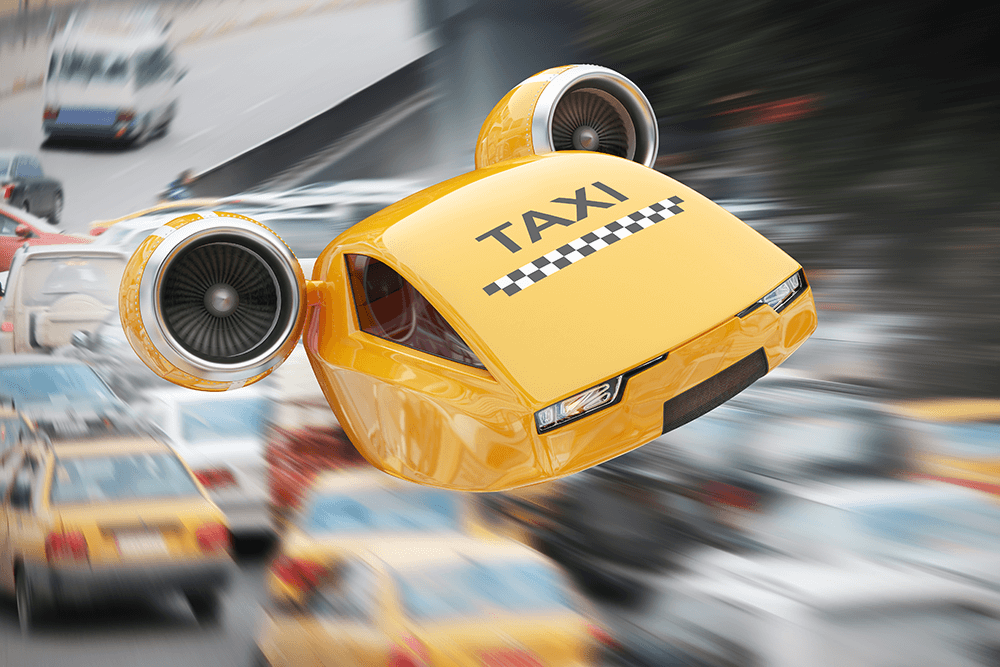Introducing The Mindboggling Flying Taxis Of The Future
2 July 2021
We already have drones and increasingly autonomous cars, so it’s perhaps no surprise that several companies are already working on flying taxis – also known as passenger drones and electrical vertical take-off and landing (eVTOL) aircraft. The first piloted eVTOL services are expected as early as this year, but we could see pilot-less autonomous eVTOLs soon after that. That’s right; autonomous flying taxis could be a reality in your lifetime.

The number of hours we used to spend sitting in traffic before the coronavirus hit is almost too depressing to think about, particularly if you live in a densely populated, congested city like Los Angeles, New York or London. Some are suggesting eVTOL services could be the answer to our traffic prayers – transporting passengers on congested city routes through the air. Meanwhile, other companies are developing eVTOLs aimed at popular intercity journeys, such as travelling from my home town of Milton Keynes to London.
Let’s take a look at some of the companies working towards the first commercial flying taxis.
EHang
This Guangzhou, China, based company develops and manufactures passenger drones. Their electric autonomous passenger area vehicle concept EHang AAV is a two-seater drone capable of carrying two passengers for up to 21 minutes or any destination about 30 miles away. The drone’s propellers even fold in, which means it could land in a standard parking space. Earlier this year, EHang became the first company to obtain a commercial licence from the Chinese government to test passenger-grade drones.
Vertical Aerospace
In 2019, British company Vertical Aerospace released footage of an eVTOL prototype completing its maiden flight at an airfield in Wales. With a top speed of around 50 mph and a total load capacity of 550 pounds, the prototype – which is called Seraph – paves the way for a passenger prototype, which the company is hoping to unveil in 2020. Vertical Aerospace appears to be targeting intercity journeys, and is on a mission to “make personal, on-demand and carbon-free flight a reality.”
Volocopter
German aviation company Volocopter has already conducted several tests of its electric, two-seater air taxi, built to carry a pilot and one passenger. The first manned urban test flight of Volocopter’s flagship 2X eVTOL aircraft – which has a range of 22 miles and a top speed of 68 mph – took place in Singapore in 2019. At the same time, Volocopter also unveiled its VoloPort solution, the world’s first flying taxi station. Clearly, Volocopter is targeting the market for short hops above busy, congested city streets rather than intercity travel, and is gunning to make flying taxis a viable, everyday solution. The company expects to begin commercial flights in 2022, transporting passengers from one VoloPort to another. Longer-term, the goal is to not need any special taxi station infrastructure, meaning you could potentially hail a Volocopter taxi from any old parking lot.
Lilium
German startup Lilium has been busy testing its five-seater Lilium Jet, which could reach top speeds of 186 mph and cover a range of 186 miles – putting Lilium firmly in the intercity camp, as opposed to short cross-city journeys. The company says it is on track to launch passenger services in a number of locations around the world by 2025.
Uber
If flying taxis really do take off (if you’ll excuse the pun), ride-sharing services like Uber could suffer. It makes sense, then, that Uber has been working on its own urban flying taxi service, with plans to launch a piloted service by 2023. Autonomous, pilot-less aircraft are expected to follow by around 2030. In 2019, Uber announced it was joining forces with Joby Aviation, a California-based aerospace company that specialises in electric aviation. Uber’s plan in partnering with Joby is to “launch a fast, reliable, clean, and affordable urban air taxi service in select markets.” Those select markets are expected to include Los Angeles, Melbourne, and Dallas.
Making flying taxis a reality
There are several issues these companies will have to overcome become they can launch passenger air taxi services. From a practical point of view, these services will (at least at first) have to run between fixed take-off and landing pads, rather than picking up and setting passengers down at their chosen destinations. This will require a lot of new infrastructure. Volocopter, with its VoloPort solution, is certainly ahead of the curve in this sense, although the company is working towards a long-term vision of making its own VoloPorts obsolete and running door-to-door services instead. Whether this vision of door-to-door travel is realistic is another matter. Most experts believe eVTOLs are simply too noisy to be allowed to land outside people’s homes, schools and offices. Air taxis will have to get a lot quieter before they can seriously challenge road taxis.
Then there’s the safety hurdle to overcome – both in terms of routine flight testing with passengers on board, and then convincing consumers that these services are safe. A whole new system of air traffic control, regulation, and legislation will be required to ensure the safe operation of air taxi services.
Finally, some experts predict air taxis will be nothing more than a premium service for the rich, as opposed to a genuine means of mass transportation. Operators will have to keep their prices affordable if they want to challenge urban taxi services and intercity travel.
Undoubtedly there are challenges to overcome, but one thing is clear: with companies like Uber working towards aggressive goals and timetables, it’s not a question of if passengers will be taking to the skies in flying taxis, but when.
Related Articles
Why The AI Supercycle Will Fail Without Advanced Networks
By now, “smart” versions exist of just about every home appliance, gadget and gizmos we can think of. However, manufacturers continue[...]
The Two-Tier AI Economy: Why Half Of Companies Are Being Left Behind And How To Close The Gap
By now, “smart” versions exist of just about every home appliance, gadget and gizmos we can think of. However, manufacturers continue[...]
5 AI-Era Skills Mistakes That Will Cost Your Business Millions In 2026
By now, “smart” versions exist of just about every home appliance, gadget and gizmos we can think of. However, manufacturers continue[...]
5 ESG Trends That Will Shape Business in 2026
By now, “smart” versions exist of just about every home appliance, gadget and gizmos we can think of. However, manufacturers continue[...]
The 5 Robotics Trends In 2026 You Must Get Ready For Now
By now, “smart” versions exist of just about every home appliance, gadget and gizmos we can think of. However, manufacturers continue[...]
10 Generative AI Trends In 2026 That Will Transform Work And Life
By now, “smart” versions exist of just about every home appliance, gadget and gizmos we can think of. However, manufacturers continue[...]
Sign up to Stay in Touch!
Bernard Marr is a world-renowned futurist, influencer and thought leader in the fields of business and technology, with a passion for using technology for the good of humanity.
He is a best-selling author of over 20 books, writes a regular column for Forbes and advises and coaches many of the world’s best-known organisations.
He has a combined following of 4 million people across his social media channels and newsletters and was ranked by LinkedIn as one of the top 5 business influencers in the world.
Bernard’s latest book is ‘Generative AI in Practice’.










Social Media